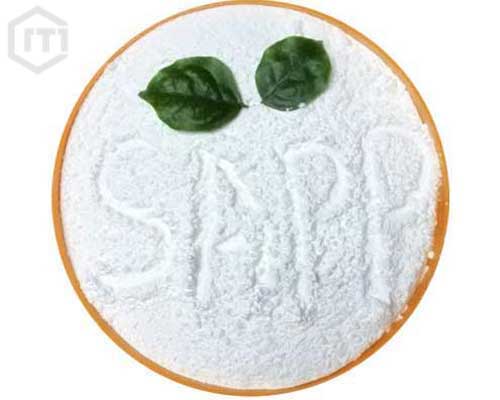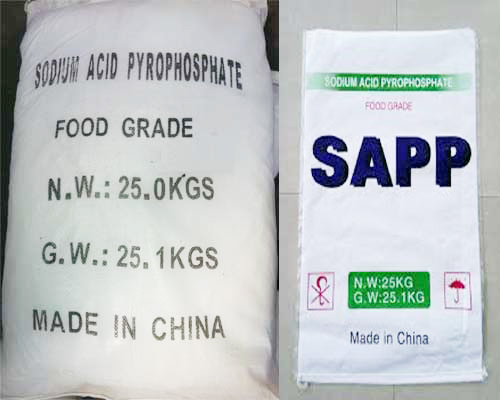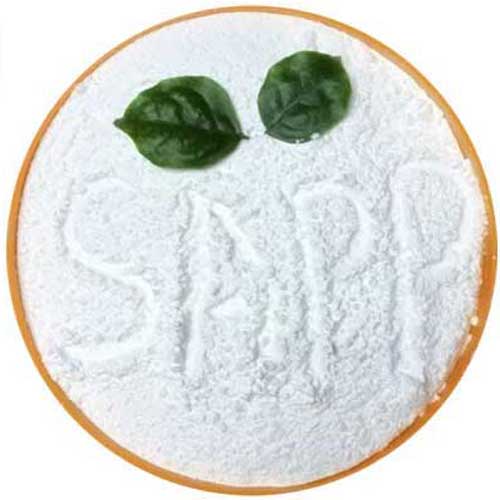

Sodium Acid Pyrophosphate SAPP Food Grade
- Appearance: White Powder or Granules
- Tech Grade: Food Grade
- Models: SAPP 28, SAPP 40
- Main Uses: Rapid leavening agent, quality improver, buffer agent, chelator, stabilizer, emulsifier, color improver, etc…
- CAS NO.: 7758-16-9
- Molecular Formular: Na2H2P2O7
- HS Code: 28352990
What Is Sodium Acid Pyrophosphate SAPP Chemical
Sodium Acid Pyrophosphate, also known as disodium dihydrogen pyrophosphate, disodium pyrophosphate, is white crystalline powder, which has the relative density of 1.864 and can decompose into sodium metaphosphate when it is heated above 220℃. it is easily soluble in water and can form chelates with Cu2+ and Fe2+. The aqueous solution can be hydrolyzed to phosphoric acid by heating with dilute sulfuric acid or dilute mineral acid. Sodium acid pyrophosphate is usually used in food processing industry. We can provide customers with high quality SAPP, contact us for price now.
| Items | Sodium Acid Pyrophosphate (SAPP) |
|---|---|
| Appearance | White crystal or crystalline power |
| Purity, % ≥ | 96% |
| Acidity(ml,0.1N NaOH 2.0g) | ≤0.2 |
| Heavy metals | ≤0.001% |
| Loss on drying | ≤1.5% |
| Moisture | ≤0.3% |
| Sulphate Ash | ≤0.1% |
Tell us more about your requirements, such as, model, quantity, package, etc. Quotation will be sent to you quickly.
Get A Free QuoteSAPP 28
SAPP 28 refers to sodium acid pyrophosphate with a fermentation rate of 24-30. Although it is often called SAPP ROR 28, the fermentation rate is not fixed, but usually a range. It is a medium speed leavening agent, as well as the most demanded specification.
SAPP 40
SAPP 40 refers to sodium acid prrophosphate with a fermentation rate of 35-43. It is a kind of fast leavening agent.
Choose SAPP 28 or SAPP 40
Different products require SAPP to produce gas at different speeds. The use of slow speed SAPP for frozen dough for biscuits and bakery products requires a slow initial rate of CO2 evolution during preparation and packaging, and a large gas evolution during the baking phase.
Medium-speed SAPP 28 is used in cakes, a part of the gas is generated in the early stage, and a part of the gas is generated after heating in the later stage. If there is too much gas in the early stage of baking, the volume will expand rapidly. At this time, the cake tissue has not yet condensed, and the finished product is easy to collapse and the tissue is thicker, but it cannot continue to expand in the later stage. If using too much slow-speed SAPP, the initial expansion will be slow, and after the product is condensed, part of the baking powder has not yet produced gas, making the cake small in size and losing the meaning of swelling.
The baking powder used for steamed buns and steamed buns needs to produce gas a little faster because the dough is relatively hard. So using fast-speed SAPP 40 will be better. If too much gas is produced after condensation, the finished product will appear “flowering”.
Customers can choose according to your requirements. Have any question, feel free to contact us for further details and quotation. You can also know more about SAPP ROR here.
Tell us more about your requirements, such as, model, quantity, package, etc. Quotation will be sent to you quickly.
Get A Free QuoteFAQ for Sodium Acid Pyrophosphate
What Is Sodium Acid Pyrophosphate Used For
Food grade sodium dihydrogen phosphate can be used as rapid leavening agent, quality improver, buffer agent, chelator, stabilizer, emulsifier, color improver, etc…
- In the barbecue food, it can control the fermentation speed and increase the production intensity.
- Used in the processing of biscuit, pastry and bread, it can prolong the storage time, make the loose gap neat and reduce the breakage rate of biscuits and cakes.
- Used in sausage processing, it can improve taste, make the color much better and increase processing speed.
- Used in the processing of aquatic products, fish balls and other frozen food, it can play a role of chelation, prevent crystal flower formation and control moisture.
- Used in the processing of instant noodle products, it can shorten the rehydration time of finished products. After rehydration, the noodles won’t be sticky and broken.
- It Is often used with sodium bicarbonate as a leavening agent in bakery products. In bakeries, SAPP is a slow fermenting acid which may contain suitable aluminium or calcium salts to control the reaction rate.
- Generally, SAPP food grade is used as the acid component in baking powder. As a chelating agent or in combination with other polyphosphates to chelate magnesium and iron ions. For example, it can chelate iron during potato processing to prevent dark discoloration.
- In French fries, the chemical reduces levels of a carcinogen called acrylamide. It also prevents discoloration of potatoes and syrup.
- In canned tuna, it can prevent the formation of harmless struvite crystals.
What Are Advantages of Sodium Acid Pyrophosphate SAPP in Baking
Sodium Acid Pyrophosphate (SAPP) is an important ingredient in double-acting baking powder and self-raising flour. Because SAPP acts slowly and doesn’t react quickly with baking soda, it is the most common self-raising flour fermentation acid used by home bakers. SAPP reacts in stages. Initially, SAPP reacts with baking soda to produce carbon dioxide gas when moisture is added to form the dough. Then the remaining gas is released when heated during the baking process.
Fermenting acids provide air and volume to the baked structure, but also affect the properties of the dough. In addition to reacting with baking soda to produce carbon dioxide gas, these acids form ionic bonds with starch and proteins in the dough. SAPP readily dissolves to form anionic pyrophosphate, which interacts with proteins in baked food systems to provide a moist texture. In addition, it provides a buffer for doughs in the pH range of 7.3-7.5, which affects the color of baked products.
Is Sodium Acid Pyrophosphate Safe
The European Food Additive Number for SAPP is E 450(i). Its safety as a food additive has been approved by the FDA, EFSA, FAO, WHO, JECFA and other authorities. It is permitted by Islamic law and qualifies as halal. E450(i) meets all “kashruth” requirements and can be certified kosher. Generally, it is vegetarian and gluten free. The manufacturing process meets the FDA’s definition of gluten-free, meaning no wheat, rye, barley, or hybrids of these grains.
First Acid Measures
- If inhaled, move patient to the place where the air is fresh immediately.
- If skin exposure, wash with soap and plenty of water.
- If entering the eyes, rinse thoroughly with plenty water for at least 15 minutes. Consult a doctor.
- If ingested accidentally, rinse the mouth immediately. Don’t give anything to an unconscious through the mouth. Consult a doctor.
Fire-fighting Measures
- Extinguishing method and extinguishing agent. Use water mist, ethanol resistant foam, dry powder or carbon dioxide to extinguish the fire.
- Phosphorus oxides and sodium oxides may cause particular harm.
- If necessary, firemen should wear self-contained breathing apparatus to put out the fire.
Emergency Treatment in case of Leakage
- Personnel protection measures, protective equipment and emergency procedures. Use personnel protective equipment. Avoid dust generation. Avoid inhalation of dust, steam and smoke. Ensure adequate ventilation.
- Environmental protection measures. Don’t let the product enter the sewer.
- Storage and removal of leaked chemicals. Don’t generate dust when collecting and disposing. Place in a suitable and closed container for processing.
Storage Precautions
- Avoid touch skin and eyes. Avoid the formation of dust and gas gel. Provide suitable exhaust equipment where dust is formed.
- Safe storage conditions. Store in a cool, dry and ventilated place. Keep container closed.
Sodium Acid Pyrophosphate Preparation
- Neutralize food grade phosphoric acid and soda ash, control the terminal PH value and generate sodium dihydrogen phosphate. Then it should be polymerized and dehydrated at a certain temperature to obtain the product SAPP.
- Dry polymerization two-step method. Add food grade soda ash to the neutralizer, heat it and make it dissolve under stirring, then add food grade phosphoric acid for neutralization reaction. The reaction end point PH value should be controlled to 4-4.4 and sodium dihydrogen phosphate can be formed. Filter the solution at 70-80℃. The filtrate can be concentrated by evaporation, cooled, crystallized, separated, and dehydrated to anhydrous sodium dihydrogen phosphate at 95℃. Send the formed anhydrous sodium dihydrogen phosphate to the tank polymerization furnace for heating and melting polymerization. Control the material temperature at 140-200℃ for polymerization. The converted sodium acid pyrophosphate is packaged after pulverization to prepare edible disodium dihydrogen pyrophosphate.
Why Choose Chemate
We are a professional manufacturer with rich production experience. We have several complete production lines, scientific production process and strict quality management system ensure our high output and excellent quality. With professional technical personnel, advanced production equipment, physical and chemical inspection facilities and product laboratories, we have strong market research and development ability, so that we can continue to meet the requirements of market and customers.
Till now, the sodium acid pyrophosphate, phosphoric acid, trisodium phosphate, sodium tripolyphosphate, sodium hexametaphosphate and some other phosphorus chemical products produced by our company have been exported to many countries and regions around the world. Because of our excellent quality, service and reasonable price, our products are loved and praised by our customers. If you have any need, please feel free to contact us, email, message and phone are available, we will reply you quickly.


